Argentina : Dreams & Stories
Copyright © 2006 by V.Delaunet
4 - Aconcagua, un long way of humility
- Descent by the valley of Los Horcones (normal way)
Lost in their thoughts, they follow the Rio Horcones for several kilometers now. The first passed without glancing to it. The last felt the presence of its mass and stop one last time to contemplate it.
 The monster seems to crush them from the immensity of its Southern face and to laugh at their failure. Could they have overcome it without this wind? Were there any other solutions than this precipitated descent? Could have they held on one day, one night more to wait until this storm ceases?
The monster seems to crush them from the immensity of its Southern face and to laugh at their failure. Could they have overcome it without this wind? Were there any other solutions than this precipitated descent? Could have they held on one day, one night more to wait until this storm ceases?
 In spite of their bitterness, all know that there was only one decision to take. One of them however, victim of his inexperience and his thoughlessness, the face burned , striated by scabs, lips bursted, the eyes purulent, is perhaps the only one who is living the 36 kilometers of descent like a relief.
In spite of their bitterness, all know that there was only one decision to take. One of them however, victim of his inexperience and his thoughlessness, the face burned , striated by scabs, lips bursted, the eyes purulent, is perhaps the only one who is living the 36 kilometers of descent like a relief.
 At the bottom of himself, in the moments of clearness the attacks of fever leave to him, he can measure the distance separating his pretension to the humility this mountain inspires with.
At the bottom of himself, in the moments of clearness the attacks of fever leave to him, he can measure the distance separating his pretension to the humility this mountain inspires with.
 Then he looks in front of him those guides (*), small points in the middle of this stones vastness. He cannot help admiring them, them who will make 5 times more during the season this effort that appeared to him so inhuman. Them, who already overcame tens of time this mountain. Them, who never complain and who attend to everything, "those conquerors of useless... " (end of the history of an expedition among so much others )
Then he looks in front of him those guides (*), small points in the middle of this stones vastness. He cannot help admiring them, them who will make 5 times more during the season this effort that appeared to him so inhuman. Them, who already overcame tens of time this mountain. Them, who never complain and who attend to everything, "those conquerors of useless... " (end of the history of an expedition among so much others )
(*) To Adrian, Matias, to the 2 Diegos, to Cedric...
To Catherine, Tony, Kevin and José
Lost in their thoughts, they follow the Rio Horcones for several kilometers now. The first passed without glancing to it. The last felt the presence of its mass and stop one last time to contemplate it.
 The monster seems to crush them from the immensity of its Southern face and to laugh at their failure. Could they have overcome it without this wind? Were there any other solutions than this precipitated descent? Could have they held on one day, one night more to wait until this storm ceases?
The monster seems to crush them from the immensity of its Southern face and to laugh at their failure. Could they have overcome it without this wind? Were there any other solutions than this precipitated descent? Could have they held on one day, one night more to wait until this storm ceases?  In spite of their bitterness, all know that there was only one decision to take. One of them however, victim of his inexperience and his thoughlessness, the face burned , striated by scabs, lips bursted, the eyes purulent, is perhaps the only one who is living the 36 kilometers of descent like a relief.
In spite of their bitterness, all know that there was only one decision to take. One of them however, victim of his inexperience and his thoughlessness, the face burned , striated by scabs, lips bursted, the eyes purulent, is perhaps the only one who is living the 36 kilometers of descent like a relief. At the bottom of himself, in the moments of clearness the attacks of fever leave to him, he can measure the distance separating his pretension to the humility this mountain inspires with.
At the bottom of himself, in the moments of clearness the attacks of fever leave to him, he can measure the distance separating his pretension to the humility this mountain inspires with. Then he looks in front of him those guides (*), small points in the middle of this stones vastness. He cannot help admiring them, them who will make 5 times more during the season this effort that appeared to him so inhuman. Them, who already overcame tens of time this mountain. Them, who never complain and who attend to everything, "those conquerors of useless... " (end of the history of an expedition among so much others )
Then he looks in front of him those guides (*), small points in the middle of this stones vastness. He cannot help admiring them, them who will make 5 times more during the season this effort that appeared to him so inhuman. Them, who already overcame tens of time this mountain. Them, who never complain and who attend to everything, "those conquerors of useless... " (end of the history of an expedition among so much others )(*) To Adrian, Matias, to the 2 Diegos, to Cedric...
To Catherine, Tony, Kevin and José
3 - Aconcagua, un long way of humility
- Camp 2 (5600m) and camp 3 (6000m, known as "colera") - alternative of the Poles way .
The days passed: they do not know any more very well since how long they left. They arrived at camp 2 the day before at the evening, in a snowstorm. One of the guides had preceded them to set up in the urgency a tent so that they can take refuge there quickly. This time, they had been afraid. Exhausted, the face pricked by the hail, the tip of the fingers already painful , wiping their mask covered by snow, staggering of tiredness, they had searched for the tent during minutes which had appeared an eternity to them. They already imagined themselves frozen .
One of the guides had preceded them to set up in the urgency a tent so that they can take refuge there quickly. This time, they had been afraid. Exhausted, the face pricked by the hail, the tip of the fingers already painful , wiping their mask covered by snow, staggering of tiredness, they had searched for the tent during minutes which had appeared an eternity to them. They already imagined themselves frozen . When the guide had appeared few meters of them, they had known that they could put an end to this nightmare. All huddled ones against the others, it had taken to them several hours before feeling blood again circulating at the tip of their fingers. The mountain had taken another dimension, that none of them with his weak experiment knew.
When the guide had appeared few meters of them, they had known that they could put an end to this nightmare. All huddled ones against the others, it had taken to them several hours before feeling blood again circulating at the tip of their fingers. The mountain had taken another dimension, that none of them with his weak experiment knew.  The next morning, the sky is limpid and they can see the Glacier of the Poles upon them. They know that they cannot move back any more. There is not other alternative that to remain in the tent to regain forces or to continue to go up. They choose to take the progression again, without respecting the day of rest, in spite of their tetanized muscles, in spite of their state of tiredness, in spite of the load of 20 kilos they have to carry. Some of them already start to count the days separating them from a bed and a shower.
The next morning, the sky is limpid and they can see the Glacier of the Poles upon them. They know that they cannot move back any more. There is not other alternative that to remain in the tent to regain forces or to continue to go up. They choose to take the progression again, without respecting the day of rest, in spite of their tetanized muscles, in spite of their state of tiredness, in spite of the load of 20 kilos they have to carry. Some of them already start to count the days separating them from a bed and a shower. At the camp 3, at 6000m approximately, they wait one day, then a second one that the gusts of frozen wind stop so that they can try the rise of the summit. But the mountain decides differently. The wind come on worse during the night, transforming them into desarticulated puppets in their tents which cannot any more shelter them. Then the guides take the only decision it should be taken: to go down... (to be continued)
At the camp 3, at 6000m approximately, they wait one day, then a second one that the gusts of frozen wind stop so that they can try the rise of the summit. But the mountain decides differently. The wind come on worse during the night, transforming them into desarticulated puppets in their tents which cannot any more shelter them. Then the guides take the only decision it should be taken: to go down... (to be continued)
The days passed: they do not know any more very well since how long they left. They arrived at camp 2 the day before at the evening, in a snowstorm.
 One of the guides had preceded them to set up in the urgency a tent so that they can take refuge there quickly. This time, they had been afraid. Exhausted, the face pricked by the hail, the tip of the fingers already painful , wiping their mask covered by snow, staggering of tiredness, they had searched for the tent during minutes which had appeared an eternity to them. They already imagined themselves frozen .
One of the guides had preceded them to set up in the urgency a tent so that they can take refuge there quickly. This time, they had been afraid. Exhausted, the face pricked by the hail, the tip of the fingers already painful , wiping their mask covered by snow, staggering of tiredness, they had searched for the tent during minutes which had appeared an eternity to them. They already imagined themselves frozen . When the guide had appeared few meters of them, they had known that they could put an end to this nightmare. All huddled ones against the others, it had taken to them several hours before feeling blood again circulating at the tip of their fingers. The mountain had taken another dimension, that none of them with his weak experiment knew.
When the guide had appeared few meters of them, they had known that they could put an end to this nightmare. All huddled ones against the others, it had taken to them several hours before feeling blood again circulating at the tip of their fingers. The mountain had taken another dimension, that none of them with his weak experiment knew.  The next morning, the sky is limpid and they can see the Glacier of the Poles upon them. They know that they cannot move back any more. There is not other alternative that to remain in the tent to regain forces or to continue to go up. They choose to take the progression again, without respecting the day of rest, in spite of their tetanized muscles, in spite of their state of tiredness, in spite of the load of 20 kilos they have to carry. Some of them already start to count the days separating them from a bed and a shower.
The next morning, the sky is limpid and they can see the Glacier of the Poles upon them. They know that they cannot move back any more. There is not other alternative that to remain in the tent to regain forces or to continue to go up. They choose to take the progression again, without respecting the day of rest, in spite of their tetanized muscles, in spite of their state of tiredness, in spite of the load of 20 kilos they have to carry. Some of them already start to count the days separating them from a bed and a shower. At the camp 3, at 6000m approximately, they wait one day, then a second one that the gusts of frozen wind stop so that they can try the rise of the summit. But the mountain decides differently. The wind come on worse during the night, transforming them into desarticulated puppets in their tents which cannot any more shelter them. Then the guides take the only decision it should be taken: to go down... (to be continued)
At the camp 3, at 6000m approximately, they wait one day, then a second one that the gusts of frozen wind stop so that they can try the rise of the summit. But the mountain decides differently. The wind come on worse during the night, transforming them into desarticulated puppets in their tents which cannot any more shelter them. Then the guides take the only decision it should be taken: to go down... (to be continued)
2 - Aconcagua, un long way of humility
- Base camp (4200m Plaza Argentina) and camp 1 (4900m) - East face
At the end of 3 days of walk and 2 nights of sleep, they reach the base camp. The less prepared, the ones accustomed to Alpine greens pastures or the tourists give up. Those which remain, feel in their muscles the 2000 meters already climbed . They think of having achieved the hardest but the days which come will be more. They do not know it yet...
The less prepared, the ones accustomed to Alpine greens pastures or the tourists give up. Those which remain, feel in their muscles the 2000 meters already climbed . They think of having achieved the hardest but the days which come will be more. They do not know it yet...
 A glacial circus, almost lunar surrounds them. The shade of Aconcagua slips slowly on the camp (*). All return inside the tents but outside the cold of the night is not bearable. Each one takes the rhythm of the camp. They will spend 3 days there to rest and be acclimatized.
A glacial circus, almost lunar surrounds them. The shade of Aconcagua slips slowly on the camp (*). All return inside the tents but outside the cold of the night is not bearable. Each one takes the rhythm of the camp. They will spend 3 days there to rest and be acclimatized.
 Snow falls during the night. The following day is a rest day and each one at the bottom of his tent kills the time which passes, slowly, trying to forget the wind which slams the tarpaulin. One fills frantically the pages of a log book, the other avoids finishing quickly the only book he has carried to not find himself alone with sinister thoughts.
Snow falls during the night. The following day is a rest day and each one at the bottom of his tent kills the time which passes, slowly, trying to forget the wind which slams the tarpaulin. One fills frantically the pages of a log book, the other avoids finishing quickly the only book he has carried to not find himself alone with sinister thoughts.  In this place where no more wound heals, there is worse than the physical suffering of the days of rise: there is this feeling of oppression, born from the minutes which appear hours, locked up in this prison of which wind and cold are the watchtowers, to smell each day more nauseous odors emanating from his body. Unless they are those of his neighbor.
In this place where no more wound heals, there is worse than the physical suffering of the days of rise: there is this feeling of oppression, born from the minutes which appear hours, locked up in this prison of which wind and cold are the watchtowers, to smell each day more nauseous odors emanating from his body. Unless they are those of his neighbor.
 To avoid the symptoms of "the apunamiento" (headaches, nauseas, giddinesses...), they must drink, drink unceasingly: at least 3 liters per day and piss as much. To piss, they should slip on 2 indeed 3 thicknesses of clothing, to put their shoes on : minutes of effort and as much when they undress themselves.
To avoid the symptoms of "the apunamiento" (headaches, nauseas, giddinesses...), they must drink, drink unceasingly: at least 3 liters per day and piss as much. To piss, they should slip on 2 indeed 3 thicknesses of clothing, to put their shoes on : minutes of effort and as much when they undress themselves.
 Then they piss in the tent, in bottle and go outside for the number two, they make in a plastic bag. They will have to transport their excrements. No waste must be abandoned on Aconcagua: even not these. Many is unaware of these scatologic details before leaving. Which become with the passing days, a throbbing concern, more difficult to support by those who have at the beginning a high opinion of themselves...(to be continued)
Then they piss in the tent, in bottle and go outside for the number two, they make in a plastic bag. They will have to transport their excrements. No waste must be abandoned on Aconcagua: even not these. Many is unaware of these scatologic details before leaving. Which become with the passing days, a throbbing concern, more difficult to support by those who have at the beginning a high opinion of themselves...(to be continued)
At the end of 3 days of walk and 2 nights of sleep, they reach the base camp.
 The less prepared, the ones accustomed to Alpine greens pastures or the tourists give up. Those which remain, feel in their muscles the 2000 meters already climbed . They think of having achieved the hardest but the days which come will be more. They do not know it yet...
The less prepared, the ones accustomed to Alpine greens pastures or the tourists give up. Those which remain, feel in their muscles the 2000 meters already climbed . They think of having achieved the hardest but the days which come will be more. They do not know it yet...  A glacial circus, almost lunar surrounds them. The shade of Aconcagua slips slowly on the camp (*). All return inside the tents but outside the cold of the night is not bearable. Each one takes the rhythm of the camp. They will spend 3 days there to rest and be acclimatized.
A glacial circus, almost lunar surrounds them. The shade of Aconcagua slips slowly on the camp (*). All return inside the tents but outside the cold of the night is not bearable. Each one takes the rhythm of the camp. They will spend 3 days there to rest and be acclimatized.  Snow falls during the night. The following day is a rest day and each one at the bottom of his tent kills the time which passes, slowly, trying to forget the wind which slams the tarpaulin. One fills frantically the pages of a log book, the other avoids finishing quickly the only book he has carried to not find himself alone with sinister thoughts.
Snow falls during the night. The following day is a rest day and each one at the bottom of his tent kills the time which passes, slowly, trying to forget the wind which slams the tarpaulin. One fills frantically the pages of a log book, the other avoids finishing quickly the only book he has carried to not find himself alone with sinister thoughts.  In this place where no more wound heals, there is worse than the physical suffering of the days of rise: there is this feeling of oppression, born from the minutes which appear hours, locked up in this prison of which wind and cold are the watchtowers, to smell each day more nauseous odors emanating from his body. Unless they are those of his neighbor.
In this place where no more wound heals, there is worse than the physical suffering of the days of rise: there is this feeling of oppression, born from the minutes which appear hours, locked up in this prison of which wind and cold are the watchtowers, to smell each day more nauseous odors emanating from his body. Unless they are those of his neighbor.  To avoid the symptoms of "the apunamiento" (headaches, nauseas, giddinesses...), they must drink, drink unceasingly: at least 3 liters per day and piss as much. To piss, they should slip on 2 indeed 3 thicknesses of clothing, to put their shoes on : minutes of effort and as much when they undress themselves.
To avoid the symptoms of "the apunamiento" (headaches, nauseas, giddinesses...), they must drink, drink unceasingly: at least 3 liters per day and piss as much. To piss, they should slip on 2 indeed 3 thicknesses of clothing, to put their shoes on : minutes of effort and as much when they undress themselves.  Then they piss in the tent, in bottle and go outside for the number two, they make in a plastic bag. They will have to transport their excrements. No waste must be abandoned on Aconcagua: even not these. Many is unaware of these scatologic details before leaving. Which become with the passing days, a throbbing concern, more difficult to support by those who have at the beginning a high opinion of themselves...(to be continued)
Then they piss in the tent, in bottle and go outside for the number two, they make in a plastic bag. They will have to transport their excrements. No waste must be abandoned on Aconcagua: even not these. Many is unaware of these scatologic details before leaving. Which become with the passing days, a throbbing concern, more difficult to support by those who have at the beginning a high opinion of themselves...(to be continued)1 - Aconcagua, un long way of humility
- approach by the valley of the guanacos
They were five. None arrived at the summit. But this broken dream was perhaps for each one of them, a victory over himself...
 Many comes to Aconcagua, proud of their preceding experiments, of their physical condition in spite of the advanced age of some and the non recognized lack of training of others. All are convinced to go at the end of the adventure.
Many comes to Aconcagua, proud of their preceding experiments, of their physical condition in spite of the advanced age of some and the non recognized lack of training of others. All are convinced to go at the end of the adventure. They thought of it for many years sometimes. Family meetings or society cocktails during the months which precede, are the occasion for them to evoke this project, the temerity of which win them admiration of those who know at least that Aconcagua is a stone heap of 7000 meters (*), somewhere in the middle of the Cordillera.
They thought of it for many years sometimes. Family meetings or society cocktails during the months which precede, are the occasion for them to evoke this project, the temerity of which win them admiration of those who know at least that Aconcagua is a stone heap of 7000 meters (*), somewhere in the middle of the Cordillera.  They repeat to the listeners pretending to impassion themselves, what they read in the reviews or the guides. Seeking to reassure their anxious entourage, as much as reassuring themselves, they repeat that this adventure does not present any technical difficulty and that it is only a succession of quiet excursions, each day a little more high.
They repeat to the listeners pretending to impassion themselves, what they read in the reviews or the guides. Seeking to reassure their anxious entourage, as much as reassuring themselves, they repeat that this adventure does not present any technical difficulty and that it is only a succession of quiet excursions, each day a little more high.
 When comes the evening, by bedside lamp light, they read again however this article about "the apunamiento", this mountains illness specific to the Andes which can go to the cerebral oedema, fearing in silence to be its future victims.
When comes the evening, by bedside lamp light, they read again however this article about "the apunamiento", this mountains illness specific to the Andes which can go to the cerebral oedema, fearing in silence to be its future victims.  A few days before the departure, they are impatient to test the glowing equipment, "Gore Tex" or "Windstopper"marked, which must multiply by ten their force and in which they absorbed a fortune. They pack, unpack hundred times their 80 liters backbag, sitting down above so that all enters in, contemplating it lovingly during hours, seeing themselves already, proud mountain dwellers, on the "Americas roof".
A few days before the departure, they are impatient to test the glowing equipment, "Gore Tex" or "Windstopper"marked, which must multiply by ten their force and in which they absorbed a fortune. They pack, unpack hundred times their 80 liters backbag, sitting down above so that all enters in, contemplating it lovingly during hours, seeing themselves already, proud mountain dwellers, on the "Americas roof".  In Mendoza, 2 days before the departure, the meeting with the guides and their future expedition companion suddenly dulls a part of their superb assurance. Measuring their respective experiencesit come home to them that theirs is perhaps a little slight, that the adventure in which they launched out, is perhaps not absolutely safe. Still worse, it looks risky...
In Mendoza, 2 days before the departure, the meeting with the guides and their future expedition companion suddenly dulls a part of their superb assurance. Measuring their respective experiencesit come home to them that theirs is perhaps a little slight, that the adventure in which they launched out, is perhaps not absolutely safe. Still worse, it looks risky...
 After a few hours of walk, there does not remain a lot of each one grandeur dreams : the flag planned for the summit day is forgotten at the bottom of the bag. The front wind, dry and cold, raises whirlwind, depositing the tracheitis germs which will not leave them any more, at the bottom of the throat of those who did not understand the importance of the "bandana" before the mouth...(To be continued)
After a few hours of walk, there does not remain a lot of each one grandeur dreams : the flag planned for the summit day is forgotten at the bottom of the bag. The front wind, dry and cold, raises whirlwind, depositing the tracheitis germs which will not leave them any more, at the bottom of the throat of those who did not understand the importance of the "bandana" before the mouth...(To be continued)
(*) 6962 m
They were five. None arrived at the summit. But this broken dream was perhaps for each one of them, a victory over himself...
 Many comes to Aconcagua, proud of their preceding experiments, of their physical condition in spite of the advanced age of some and the non recognized lack of training of others. All are convinced to go at the end of the adventure.
Many comes to Aconcagua, proud of their preceding experiments, of their physical condition in spite of the advanced age of some and the non recognized lack of training of others. All are convinced to go at the end of the adventure. They thought of it for many years sometimes. Family meetings or society cocktails during the months which precede, are the occasion for them to evoke this project, the temerity of which win them admiration of those who know at least that Aconcagua is a stone heap of 7000 meters (*), somewhere in the middle of the Cordillera.
They thought of it for many years sometimes. Family meetings or society cocktails during the months which precede, are the occasion for them to evoke this project, the temerity of which win them admiration of those who know at least that Aconcagua is a stone heap of 7000 meters (*), somewhere in the middle of the Cordillera.  They repeat to the listeners pretending to impassion themselves, what they read in the reviews or the guides. Seeking to reassure their anxious entourage, as much as reassuring themselves, they repeat that this adventure does not present any technical difficulty and that it is only a succession of quiet excursions, each day a little more high.
They repeat to the listeners pretending to impassion themselves, what they read in the reviews or the guides. Seeking to reassure their anxious entourage, as much as reassuring themselves, they repeat that this adventure does not present any technical difficulty and that it is only a succession of quiet excursions, each day a little more high.  When comes the evening, by bedside lamp light, they read again however this article about "the apunamiento", this mountains illness specific to the Andes which can go to the cerebral oedema, fearing in silence to be its future victims.
When comes the evening, by bedside lamp light, they read again however this article about "the apunamiento", this mountains illness specific to the Andes which can go to the cerebral oedema, fearing in silence to be its future victims.  A few days before the departure, they are impatient to test the glowing equipment, "Gore Tex" or "Windstopper"marked, which must multiply by ten their force and in which they absorbed a fortune. They pack, unpack hundred times their 80 liters backbag, sitting down above so that all enters in, contemplating it lovingly during hours, seeing themselves already, proud mountain dwellers, on the "Americas roof".
A few days before the departure, they are impatient to test the glowing equipment, "Gore Tex" or "Windstopper"marked, which must multiply by ten their force and in which they absorbed a fortune. They pack, unpack hundred times their 80 liters backbag, sitting down above so that all enters in, contemplating it lovingly during hours, seeing themselves already, proud mountain dwellers, on the "Americas roof".  In Mendoza, 2 days before the departure, the meeting with the guides and their future expedition companion suddenly dulls a part of their superb assurance. Measuring their respective experiencesit come home to them that theirs is perhaps a little slight, that the adventure in which they launched out, is perhaps not absolutely safe. Still worse, it looks risky...
In Mendoza, 2 days before the departure, the meeting with the guides and their future expedition companion suddenly dulls a part of their superb assurance. Measuring their respective experiencesit come home to them that theirs is perhaps a little slight, that the adventure in which they launched out, is perhaps not absolutely safe. Still worse, it looks risky...  After a few hours of walk, there does not remain a lot of each one grandeur dreams : the flag planned for the summit day is forgotten at the bottom of the bag. The front wind, dry and cold, raises whirlwind, depositing the tracheitis germs which will not leave them any more, at the bottom of the throat of those who did not understand the importance of the "bandana" before the mouth...(To be continued)
After a few hours of walk, there does not remain a lot of each one grandeur dreams : the flag planned for the summit day is forgotten at the bottom of the bag. The front wind, dry and cold, raises whirlwind, depositing the tracheitis germs which will not leave them any more, at the bottom of the throat of those who did not understand the importance of the "bandana" before the mouth...(To be continued)(*) 6962 m
Inside the Pilar's blue eyes...(the jacaranda legend)
What there was in the Pilar glance so that Mbareté drowns in, so much so that losing his life ? She had arrived a few weeks earlier in this village which still was named "las siete corrientes". Her father, of Spanish gentry, had brought her with him. They had settled both not far from the Jesuit mission where worked many guaranis.
She had arrived a few weeks earlier in this village which still was named "las siete corrientes". Her father, of Spanish gentry, had brought her with him. They had settled both not far from the Jesuit mission where worked many guaranis.  It made a little fresher late in the afternoon. She wanted to go out and asked to her lady's companion to come with her. Indolente, she walked on the alleys of the "reducción". Her sunshade whirled above her head, protecting her skin that her black hair made even whiter.
It made a little fresher late in the afternoon. She wanted to go out and asked to her lady's companion to come with her. Indolente, she walked on the alleys of the "reducción". Her sunshade whirled above her head, protecting her skin that her black hair made even whiter.  Mbareté should have never to pick himself up to sponge the sweat which ran down his forehead. At 16 years just completed, Pilar could not either mask the feeling which had seized her, when her profound blue glance had crossed that of the young Indian.
Mbareté should have never to pick himself up to sponge the sweat which ran down his forehead. At 16 years just completed, Pilar could not either mask the feeling which had seized her, when her profound blue glance had crossed that of the young Indian.  They ever since made use of everything to met them again, another time, then others. Mbareté learned some words from Spanish : sufficiently so that he can stammer in Pilar's ear those she dreamed to hear.
They ever since made use of everything to met them again, another time, then others. Mbareté learned some words from Spanish : sufficiently so that he can stammer in Pilar's ear those she dreamed to hear.  But one night, deciding to love themselves more, they were surprised by the father of Pilar. Determinated to wash in blood the honor of his daughter, he thrusted a musket to Mbareté. When the shot went out, Pilar threw herself to protect her beloved. She died without a cry. Swept by a second shot at the time he was rushing upon the Pilar's father, Mbareté collapsed on the girl.
But one night, deciding to love themselves more, they were surprised by the father of Pilar. Determinated to wash in blood the honor of his daughter, he thrusted a musket to Mbareté. When the shot went out, Pilar threw herself to protect her beloved. She died without a cry. Swept by a second shot at the time he was rushing upon the Pilar's father, Mbareté collapsed on the girl.
Much later, those who came back to the scene of the drama, discovered at the place the lovers body had fallen interlaced , a tree with blue flowers, from the profound blue of the pilar's glance. Thus was born the jacaranda legend...
 She had arrived a few weeks earlier in this village which still was named "las siete corrientes". Her father, of Spanish gentry, had brought her with him. They had settled both not far from the Jesuit mission where worked many guaranis.
She had arrived a few weeks earlier in this village which still was named "las siete corrientes". Her father, of Spanish gentry, had brought her with him. They had settled both not far from the Jesuit mission where worked many guaranis.  It made a little fresher late in the afternoon. She wanted to go out and asked to her lady's companion to come with her. Indolente, she walked on the alleys of the "reducción". Her sunshade whirled above her head, protecting her skin that her black hair made even whiter.
It made a little fresher late in the afternoon. She wanted to go out and asked to her lady's companion to come with her. Indolente, she walked on the alleys of the "reducción". Her sunshade whirled above her head, protecting her skin that her black hair made even whiter.  Mbareté should have never to pick himself up to sponge the sweat which ran down his forehead. At 16 years just completed, Pilar could not either mask the feeling which had seized her, when her profound blue glance had crossed that of the young Indian.
Mbareté should have never to pick himself up to sponge the sweat which ran down his forehead. At 16 years just completed, Pilar could not either mask the feeling which had seized her, when her profound blue glance had crossed that of the young Indian.  They ever since made use of everything to met them again, another time, then others. Mbareté learned some words from Spanish : sufficiently so that he can stammer in Pilar's ear those she dreamed to hear.
They ever since made use of everything to met them again, another time, then others. Mbareté learned some words from Spanish : sufficiently so that he can stammer in Pilar's ear those she dreamed to hear.  But one night, deciding to love themselves more, they were surprised by the father of Pilar. Determinated to wash in blood the honor of his daughter, he thrusted a musket to Mbareté. When the shot went out, Pilar threw herself to protect her beloved. She died without a cry. Swept by a second shot at the time he was rushing upon the Pilar's father, Mbareté collapsed on the girl.
But one night, deciding to love themselves more, they were surprised by the father of Pilar. Determinated to wash in blood the honor of his daughter, he thrusted a musket to Mbareté. When the shot went out, Pilar threw herself to protect her beloved. She died without a cry. Swept by a second shot at the time he was rushing upon the Pilar's father, Mbareté collapsed on the girl. Much later, those who came back to the scene of the drama, discovered at the place the lovers body had fallen interlaced , a tree with blue flowers, from the profound blue of the pilar's glance. Thus was born the jacaranda legend...
The Victoria's legacy (Villa Ocampo - San Isidro)
The last sunbeams light the recently roughcasted façade. The fine gravels grate under the steps of the last walkers. In the alleys, under the shade of secular ombus or araucarias, benches offer ultimate moments of confidences to the ones in love, before they plunge in the city's hubbub.  Come to contemplate the works of art exposed inside the property or to enjoy the freshness of the park drawn by Don Manuel Ocampo (father of Victoria), the occasional visitor could not imagine that the roof of this beautiful residence was devastated 3 years earlier by a terrible fire, whereas began works of its restoration.
Come to contemplate the works of art exposed inside the property or to enjoy the freshness of the park drawn by Don Manuel Ocampo (father of Victoria), the occasional visitor could not imagine that the roof of this beautiful residence was devastated 3 years earlier by a terrible fire, whereas began works of its restoration.  The will, the passion of a team (*) placed under the supervision of UNESCO allowed that survive the house of the one who "dedicated her fortune, ... considerable, to the education of her country and of her continent". Borges added besides on a purely personal basis: "…I owe a great deal to Victoria, but as an Argentine, I owe her far more."
The will, the passion of a team (*) placed under the supervision of UNESCO allowed that survive the house of the one who "dedicated her fortune, ... considerable, to the education of her country and of her continent". Borges added besides on a purely personal basis: "…I owe a great deal to Victoria, but as an Argentine, I owe her far more."
 Victoria had moved definitively into this house in 1942. Prestigious names of the world of arts had crossed its threshold for a long time already. They had come there to seek the calm favourable to the inspiration. They had found there the fascination this woman exerted, become little by little their muse and their protectress.
Victoria had moved definitively into this house in 1942. Prestigious names of the world of arts had crossed its threshold for a long time already. They had come there to seek the calm favourable to the inspiration. They had found there the fascination this woman exerted, become little by little their muse and their protectress.
 Rabindranath Tagore wrote at the end of his life that he "did not know her language but the words spoken by her eyes will endure forever, so eloquent in their anguish.”. Hermann Keyserling acknowledged that he "(had been) enslaved by the most spiritual woman (he) had ever met.”
Rabindranath Tagore wrote at the end of his life that he "did not know her language but the words spoken by her eyes will endure forever, so eloquent in their anguish.”. Hermann Keyserling acknowledged that he "(had been) enslaved by the most spiritual woman (he) had ever met.”
 But the most beautiful homage was that of Borges little after the death of Victoria, in 1979: "She lived with valor and decorum, her own life... She possessed, ...the grace that heaven didn’t deign offer me".
But the most beautiful homage was that of Borges little after the death of Victoria, in 1979: "She lived with valor and decorum, her own life... She possessed, ...the grace that heaven didn’t deign offer me".
Ramona Victoria Epifanía Rufina Ocampo, called Victoria Ocampo (1890-1979)
Villa Ocampo Project
www.villaocampo.org
(*) Special thanks to Neda Ferrier (Villa Ocampo project- UNESCO) to have allowed me to discover this place.
 Come to contemplate the works of art exposed inside the property or to enjoy the freshness of the park drawn by Don Manuel Ocampo (father of Victoria), the occasional visitor could not imagine that the roof of this beautiful residence was devastated 3 years earlier by a terrible fire, whereas began works of its restoration.
Come to contemplate the works of art exposed inside the property or to enjoy the freshness of the park drawn by Don Manuel Ocampo (father of Victoria), the occasional visitor could not imagine that the roof of this beautiful residence was devastated 3 years earlier by a terrible fire, whereas began works of its restoration.  The will, the passion of a team (*) placed under the supervision of UNESCO allowed that survive the house of the one who "dedicated her fortune, ... considerable, to the education of her country and of her continent". Borges added besides on a purely personal basis: "…I owe a great deal to Victoria, but as an Argentine, I owe her far more."
The will, the passion of a team (*) placed under the supervision of UNESCO allowed that survive the house of the one who "dedicated her fortune, ... considerable, to the education of her country and of her continent". Borges added besides on a purely personal basis: "…I owe a great deal to Victoria, but as an Argentine, I owe her far more." Victoria had moved definitively into this house in 1942. Prestigious names of the world of arts had crossed its threshold for a long time already. They had come there to seek the calm favourable to the inspiration. They had found there the fascination this woman exerted, become little by little their muse and their protectress.
Victoria had moved definitively into this house in 1942. Prestigious names of the world of arts had crossed its threshold for a long time already. They had come there to seek the calm favourable to the inspiration. They had found there the fascination this woman exerted, become little by little their muse and their protectress. Rabindranath Tagore wrote at the end of his life that he "did not know her language but the words spoken by her eyes will endure forever, so eloquent in their anguish.”. Hermann Keyserling acknowledged that he "(had been) enslaved by the most spiritual woman (he) had ever met.”
Rabindranath Tagore wrote at the end of his life that he "did not know her language but the words spoken by her eyes will endure forever, so eloquent in their anguish.”. Hermann Keyserling acknowledged that he "(had been) enslaved by the most spiritual woman (he) had ever met.” But the most beautiful homage was that of Borges little after the death of Victoria, in 1979: "She lived with valor and decorum, her own life... She possessed, ...the grace that heaven didn’t deign offer me".
But the most beautiful homage was that of Borges little after the death of Victoria, in 1979: "She lived with valor and decorum, her own life... She possessed, ...the grace that heaven didn’t deign offer me".Ramona Victoria Epifanía Rufina Ocampo, called Victoria Ocampo (1890-1979)
Villa Ocampo Project
www.villaocampo.org
(*) Special thanks to Neda Ferrier (Villa Ocampo project- UNESCO) to have allowed me to discover this place.
The dawn of the city of Ushuaia
The vast desert lands located at the south of Rio Negro and Rio Neuquen worried the authorities of Buenos Aires only because of the quarrelsome Indians (Mapuches) they sheltered, guilty of ceaseless "malones" in the middle of the Pampa's estancieros lands.
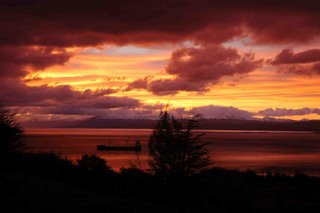 Beyond, still coarse maps mentioned the existence of a more or less triangular drawing island , that the sailors of Magellan had baptized in 1520 "Tierra del Fuego", without knowing that fires in question emanated from encampments of Indians established there for thousand years.
Beyond, still coarse maps mentioned the existence of a more or less triangular drawing island , that the sailors of Magellan had baptized in 1520 "Tierra del Fuego", without knowing that fires in question emanated from encampments of Indians established there for thousand years.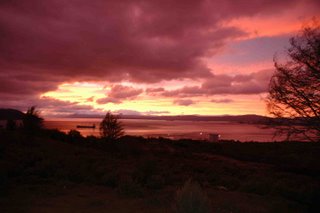 They were called Onas (or Selkman) and Yamanas. Contrary to their cousins of North, they were peaceful, lived hunting and fishing on a territory to which they had given, for a long time already, the name of "Karukinka".
They were called Onas (or Selkman) and Yamanas. Contrary to their cousins of North, they were peaceful, lived hunting and fishing on a territory to which they had given, for a long time already, the name of "Karukinka".
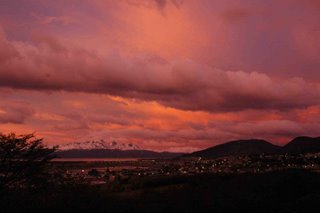 Other ships followed the passage of the Magellan one's during following centuries, but direct contacts with the white man were rare. It happened that certain generations were aware of his existence only through tales of the oldest.
Other ships followed the passage of the Magellan one's during following centuries, but direct contacts with the white man were rare. It happened that certain generations were aware of his existence only through tales of the oldest.
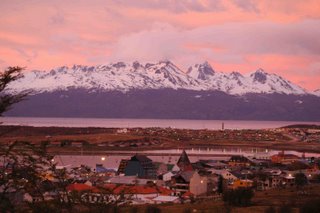 But during this year 1884, if oldest remembered the passage of the “Beagle", 50 years earlier, youngest had got into habit of keeping close to English missionaires like Pastors Mathews and Bridges and other men overcome by goldfever, settled in the north of the island.
But during this year 1884, if oldest remembered the passage of the “Beagle", 50 years earlier, youngest had got into habit of keeping close to English missionaires like Pastors Mathews and Bridges and other men overcome by goldfever, settled in the north of the island. Did they understand the consequence of the gesture achieved by Commander Augusto Laserre at the head of the Argentinian Army South Atlantic task force, on this 12th of October : that this flag set up in this bay they used to call Ushuaïa, meant the birth of new city, and by inches their people death ?
Did they understand the consequence of the gesture achieved by Commander Augusto Laserre at the head of the Argentinian Army South Atlantic task force, on this 12th of October : that this flag set up in this bay they used to call Ushuaïa, meant the birth of new city, and by inches their people death ?
Natural photographs taken without filter at 5h30 a.m. on October 4, 2006
 Beyond, still coarse maps mentioned the existence of a more or less triangular drawing island , that the sailors of Magellan had baptized in 1520 "Tierra del Fuego", without knowing that fires in question emanated from encampments of Indians established there for thousand years.
Beyond, still coarse maps mentioned the existence of a more or less triangular drawing island , that the sailors of Magellan had baptized in 1520 "Tierra del Fuego", without knowing that fires in question emanated from encampments of Indians established there for thousand years. They were called Onas (or Selkman) and Yamanas. Contrary to their cousins of North, they were peaceful, lived hunting and fishing on a territory to which they had given, for a long time already, the name of "Karukinka".
They were called Onas (or Selkman) and Yamanas. Contrary to their cousins of North, they were peaceful, lived hunting and fishing on a territory to which they had given, for a long time already, the name of "Karukinka". Other ships followed the passage of the Magellan one's during following centuries, but direct contacts with the white man were rare. It happened that certain generations were aware of his existence only through tales of the oldest.
Other ships followed the passage of the Magellan one's during following centuries, but direct contacts with the white man were rare. It happened that certain generations were aware of his existence only through tales of the oldest. But during this year 1884, if oldest remembered the passage of the “Beagle", 50 years earlier, youngest had got into habit of keeping close to English missionaires like Pastors Mathews and Bridges and other men overcome by goldfever, settled in the north of the island.
But during this year 1884, if oldest remembered the passage of the “Beagle", 50 years earlier, youngest had got into habit of keeping close to English missionaires like Pastors Mathews and Bridges and other men overcome by goldfever, settled in the north of the island. Did they understand the consequence of the gesture achieved by Commander Augusto Laserre at the head of the Argentinian Army South Atlantic task force, on this 12th of October : that this flag set up in this bay they used to call Ushuaïa, meant the birth of new city, and by inches their people death ?
Did they understand the consequence of the gesture achieved by Commander Augusto Laserre at the head of the Argentinian Army South Atlantic task force, on this 12th of October : that this flag set up in this bay they used to call Ushuaïa, meant the birth of new city, and by inches their people death ?Natural photographs taken without filter at 5h30 a.m. on October 4, 2006
A page of the “HMS Beagle” logbook
Savages, very dirty, idiots! no understand.” Jemmy Button exclaims.  All around him, hundreds of Yamanas try to touch him, to smell the strange flavour emanating from this small fellow they do not recognize. Only wearing filth that protects them from the cold, they upset this dandy and the girl who stands at his sides.
All around him, hundreds of Yamanas try to touch him, to smell the strange flavour emanating from this small fellow they do not recognize. Only wearing filth that protects them from the cold, they upset this dandy and the girl who stands at his sides.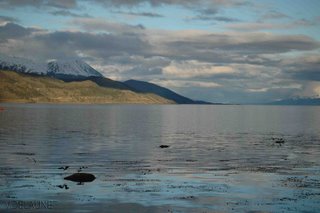 Fuegia Basket is still thinking of this day she was presented at the King and the Queen. Nervously, she makes turn a sunshade above her head and mumble to these “savages” who were her brothers, in English she reminds : “I, forgotten speak Yamana”.
Fuegia Basket is still thinking of this day she was presented at the King and the Queen. Nervously, she makes turn a sunshade above her head and mumble to these “savages” who were her brothers, in English she reminds : “I, forgotten speak Yamana”.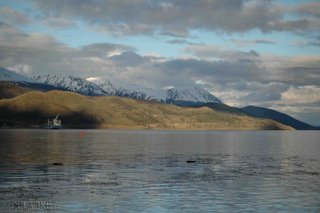 Beside them, stand three other strange creatures landed from a canot much larger than those used by Yamanas: Robert Fitz Roy, captain of the brig HMS Beagle, Charles Darwin, a young man that Jemmy and Fuegia have immediately hated, and Pastor Mathews who reads these so beautiful stories that they do not all understand.
Beside them, stand three other strange creatures landed from a canot much larger than those used by Yamanas: Robert Fitz Roy, captain of the brig HMS Beagle, Charles Darwin, a young man that Jemmy and Fuegia have immediately hated, and Pastor Mathews who reads these so beautiful stories that they do not all understand.
They all left the port of Devonport in England, on December 27, 1831, nearly one year ago. The Captain Fitz Roy was commissioned to continue the work of chronometric and topographic readings made by the Captain King between 1826 and 1830. He makes cast anchor this afternoon of December 17, 1832, in a bay the English maps of the time mention under the name of “Bay of Good Success” close to the Navarino island.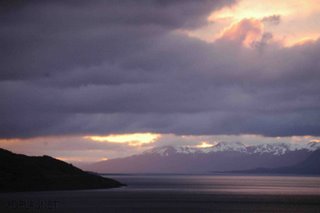 On this island will end an experiment involuntarily started 3 years earlier, during the first Beagle expedition. At that time, a group of Yamanas had seized a small whale-boat they found useful to go to fish. The Captain, to recover this property of “His Majesty”, had not hesitated to take 4 Indians as hostages.
On this island will end an experiment involuntarily started 3 years earlier, during the first Beagle expedition. At that time, a group of Yamanas had seized a small whale-boat they found useful to go to fish. The Captain, to recover this property of “His Majesty”, had not hesitated to take 4 Indians as hostages.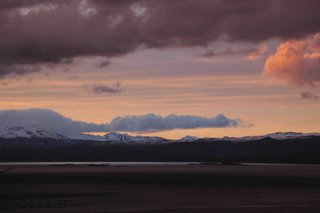 The aforementioned hostages found very pleasant the fact of washing and dressing themselves. So that they stayed on board, quickly becoming the mascots of the crew which gave to them ridiculous names. When they arrived in England they became the crowd attraction. Showered with gifts, they were the guests of the London best society salons.
The aforementioned hostages found very pleasant the fact of washing and dressing themselves. So that they stayed on board, quickly becoming the mascots of the crew which gave to them ridiculous names. When they arrived in England they became the crowd attraction. Showered with gifts, they were the guests of the London best society salons. Feeling guilty to have transformed them into fair attractions, Robert Fitz Roy thus seizes the opportunity of a second voyage to take them home with Pasteur Mathews in charge to found a mission on the island which faces the current site of the Ushuaïa city. Thus it explains this surrealist episode of Beagle expedition…
Feeling guilty to have transformed them into fair attractions, Robert Fitz Roy thus seizes the opportunity of a second voyage to take them home with Pasteur Mathews in charge to found a mission on the island which faces the current site of the Ushuaïa city. Thus it explains this surrealist episode of Beagle expedition…
Thanks to Jean Raspail for this anecdote drawn from his book "Adios, Tierra del Fuego" Ed.Albin Michel
 All around him, hundreds of Yamanas try to touch him, to smell the strange flavour emanating from this small fellow they do not recognize. Only wearing filth that protects them from the cold, they upset this dandy and the girl who stands at his sides.
All around him, hundreds of Yamanas try to touch him, to smell the strange flavour emanating from this small fellow they do not recognize. Only wearing filth that protects them from the cold, they upset this dandy and the girl who stands at his sides. Fuegia Basket is still thinking of this day she was presented at the King and the Queen. Nervously, she makes turn a sunshade above her head and mumble to these “savages” who were her brothers, in English she reminds : “I, forgotten speak Yamana”.
Fuegia Basket is still thinking of this day she was presented at the King and the Queen. Nervously, she makes turn a sunshade above her head and mumble to these “savages” who were her brothers, in English she reminds : “I, forgotten speak Yamana”. Beside them, stand three other strange creatures landed from a canot much larger than those used by Yamanas: Robert Fitz Roy, captain of the brig HMS Beagle, Charles Darwin, a young man that Jemmy and Fuegia have immediately hated, and Pastor Mathews who reads these so beautiful stories that they do not all understand.
Beside them, stand three other strange creatures landed from a canot much larger than those used by Yamanas: Robert Fitz Roy, captain of the brig HMS Beagle, Charles Darwin, a young man that Jemmy and Fuegia have immediately hated, and Pastor Mathews who reads these so beautiful stories that they do not all understand.They all left the port of Devonport in England, on December 27, 1831, nearly one year ago. The Captain Fitz Roy was commissioned to continue the work of chronometric and topographic readings made by the Captain King between 1826 and 1830. He makes cast anchor this afternoon of December 17, 1832, in a bay the English maps of the time mention under the name of “Bay of Good Success” close to the Navarino island.
 On this island will end an experiment involuntarily started 3 years earlier, during the first Beagle expedition. At that time, a group of Yamanas had seized a small whale-boat they found useful to go to fish. The Captain, to recover this property of “His Majesty”, had not hesitated to take 4 Indians as hostages.
On this island will end an experiment involuntarily started 3 years earlier, during the first Beagle expedition. At that time, a group of Yamanas had seized a small whale-boat they found useful to go to fish. The Captain, to recover this property of “His Majesty”, had not hesitated to take 4 Indians as hostages. The aforementioned hostages found very pleasant the fact of washing and dressing themselves. So that they stayed on board, quickly becoming the mascots of the crew which gave to them ridiculous names. When they arrived in England they became the crowd attraction. Showered with gifts, they were the guests of the London best society salons.
The aforementioned hostages found very pleasant the fact of washing and dressing themselves. So that they stayed on board, quickly becoming the mascots of the crew which gave to them ridiculous names. When they arrived in England they became the crowd attraction. Showered with gifts, they were the guests of the London best society salons. Feeling guilty to have transformed them into fair attractions, Robert Fitz Roy thus seizes the opportunity of a second voyage to take them home with Pasteur Mathews in charge to found a mission on the island which faces the current site of the Ushuaïa city. Thus it explains this surrealist episode of Beagle expedition…
Feeling guilty to have transformed them into fair attractions, Robert Fitz Roy thus seizes the opportunity of a second voyage to take them home with Pasteur Mathews in charge to found a mission on the island which faces the current site of the Ushuaïa city. Thus it explains this surrealist episode of Beagle expedition…Thanks to Jean Raspail for this anecdote drawn from his book "Adios, Tierra del Fuego" Ed.Albin Michel
Back to Tierra del Fuego (Cerro Castor)
We are at the beginning of October. The ski season is finished everywhere else in the southern hemisphere. Except in Ushuaïa. There, some fans, and a privileged few, come to benefit from the last snows suspended from the glaciar valleys sides of the Tierra del Fuego.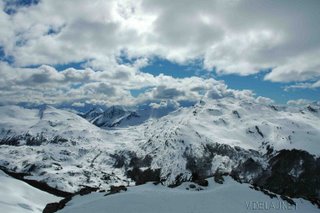
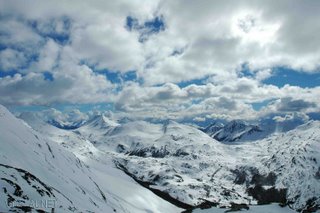 At the side of Ruta 3 which leads to Rio Gallegos, a human dimensions ski complex has developed for 6 years, named without originality Cerro Castor, in connection with the hundred thousands of these small awkwardly introduced rodents, and which devastate the surrounding forest of lengas.
At the side of Ruta 3 which leads to Rio Gallegos, a human dimensions ski complex has developed for 6 years, named without originality Cerro Castor, in connection with the hundred thousands of these small awkwardly introduced rodents, and which devastate the surrounding forest of lengas.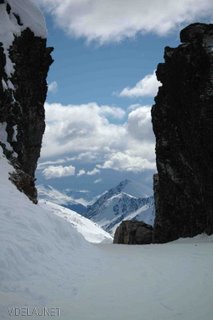 A few days earlier, snowboard France team passed to prepare the season which will start in the northern hemisphere. Under the expert glance of ten Ushuaïa freestylers, they make fun of “half pipes” and “pro jump” in an all in concavities relief. they left a pure trace in the powdered snow, and figures in the spirits, which it will have to reproduce at any price.
A few days earlier, snowboard France team passed to prepare the season which will start in the northern hemisphere. Under the expert glance of ten Ushuaïa freestylers, they make fun of “half pipes” and “pro jump” in an all in concavities relief. they left a pure trace in the powdered snow, and figures in the spirits, which it will have to reproduce at any price. Part of the privileged youth of Ushuaïa practises these new feelings with much of virtuosity and unconcern within surroundings they know by heart, challenging themselves to the possible frontier.
Part of the privileged youth of Ushuaïa practises these new feelings with much of virtuosity and unconcern within surroundings they know by heart, challenging themselves to the possible frontier. In the evening, after having removed the “baggy”, they descend the street San Martin showing to the girls faces of those who were there, of those who did it, telling the “1080°” they made and that nobody saw.
In the evening, after having removed the “baggy”, they descend the street San Martin showing to the girls faces of those who were there, of those who did it, telling the “1080°” they made and that nobody saw.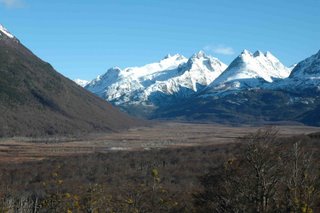
Cerro Castor ski center :
www.cerrocastor.com
(00 54) 29 0149-9301

 At the side of Ruta 3 which leads to Rio Gallegos, a human dimensions ski complex has developed for 6 years, named without originality Cerro Castor, in connection with the hundred thousands of these small awkwardly introduced rodents, and which devastate the surrounding forest of lengas.
At the side of Ruta 3 which leads to Rio Gallegos, a human dimensions ski complex has developed for 6 years, named without originality Cerro Castor, in connection with the hundred thousands of these small awkwardly introduced rodents, and which devastate the surrounding forest of lengas. A few days earlier, snowboard France team passed to prepare the season which will start in the northern hemisphere. Under the expert glance of ten Ushuaïa freestylers, they make fun of “half pipes” and “pro jump” in an all in concavities relief. they left a pure trace in the powdered snow, and figures in the spirits, which it will have to reproduce at any price.
A few days earlier, snowboard France team passed to prepare the season which will start in the northern hemisphere. Under the expert glance of ten Ushuaïa freestylers, they make fun of “half pipes” and “pro jump” in an all in concavities relief. they left a pure trace in the powdered snow, and figures in the spirits, which it will have to reproduce at any price. Part of the privileged youth of Ushuaïa practises these new feelings with much of virtuosity and unconcern within surroundings they know by heart, challenging themselves to the possible frontier.
Part of the privileged youth of Ushuaïa practises these new feelings with much of virtuosity and unconcern within surroundings they know by heart, challenging themselves to the possible frontier. In the evening, after having removed the “baggy”, they descend the street San Martin showing to the girls faces of those who were there, of those who did it, telling the “1080°” they made and that nobody saw.
In the evening, after having removed the “baggy”, they descend the street San Martin showing to the girls faces of those who were there, of those who did it, telling the “1080°” they made and that nobody saw.
Cerro Castor ski center :
www.cerrocastor.com
(00 54) 29 0149-9301
Subscribe to:
Posts (Atom)